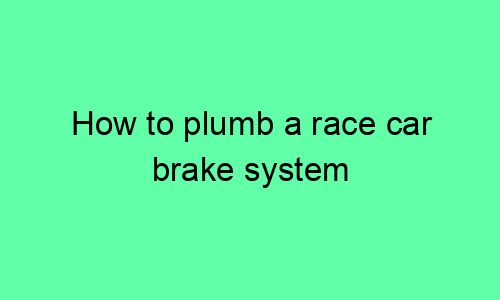- How to Plumb a Race Car Brake System
- Introduction
- Tools and Materials
- Steps
- 1. Plan the layout
- 2. Install the brake master cylinder
- 3. Install the brake calipers
- 4. Install the brake lines
- 5. Flare the brake lines
- 6. Install the brake fittings
- 7. Fill the brake system with fluid
- 8. Bleed the brake system
- Conclusion
How to Plumb a Race Car Brake System
Introduction
A well-plumbed brake system is essential for the safety and performance of any race car. The brake system is responsible for slowing down the car and bringing it to a stop, and it must be able to do so reliably and efficiently. In this guide, we will walk you through the steps on how to plumb a race car brake system.
Tools and Materials
- Brake line
- Brake fittings
- Brake fluid
- Flare tool
- Wrench
- Safety glasses
Steps
1. Plan the layout
The first step is to plan the layout of the brake system. This includes determining the location of the brake master cylinder, brake calipers, and brake lines. You will also need to decide on the type of brake fluid you will be using.
2. Install the brake master cylinder
The brake master cylinder is the heart of the brake system. It is responsible for converting the force from the brake pedal into hydraulic pressure. The brake master cylinder is typically mounted on the firewall of the car.
3. Install the brake calipers
The brake calipers are responsible for applying pressure to the brake pads. The brake calipers are mounted on the wheels of the car.
4. Install the brake lines
The brake lines are responsible for carrying the brake fluid from the brake master cylinder to the brake calipers. The brake lines are typically made of steel or stainless steel.
5. Flare the brake lines
The brake lines must be flared at the ends in order to connect them to the brake master cylinder and brake calipers. A flare tool is used to create the flares.
6. Install the brake fittings
The brake fittings are used to connect the brake lines to the brake master cylinder and brake calipers. The brake fittings are typically made of brass or aluminum.
7. Fill the brake system with fluid
Once the brake system is plumbed, it must be filled with brake fluid. The brake fluid is responsible for transferring the pressure from the brake master cylinder to the brake calipers.
8. Bleed the brake system
Once the brake system is filled with fluid, it must be bled. Bleeding the brake system removes any air from the system. Air in the brake system can cause the brakes to be spongy and ineffective.
Conclusion
Plumbing a race car brake system is a complex task, but it is essential for the safety and performance of the car. By following the steps outlined in this guide, you can plumb a brake system that will provide you with years of reliable service.






